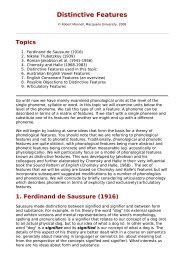The Syllable and the Foot : Summary - Speech Resource Pages
The Syllable and the Foot : Summary - Speech Resource Pages
The Syllable and the Foot : Summary - Speech Resource Pages
Create successful ePaper yourself
Turn your PDF publications into a flip-book with our unique Google optimized e-Paper software.
syllable cannot be associated with a preceding foot which is<br />
on <strong>the</strong> o<strong>the</strong>r side of an intonational phrase boundary. (see <strong>the</strong><br />
topic on Intonation, for more information on prosodic<br />
phrases).<br />
• Some words, such as "was" <strong>and</strong> "when", which can be<br />
unstressed are stressed in a Limerick because <strong>the</strong> structure of<br />
<strong>the</strong> Limerick places an accent on <strong>the</strong>m. <strong>The</strong> lines of <strong>the</strong><br />
Limerick are realised as intonational phrases, but <strong>the</strong><br />
placement of accents on <strong>the</strong> capitalised words in this Limerick<br />
divides <strong>the</strong>se intonational phrases into two or three<br />
intermediate phrases (a lower level prosodic phrase<br />
containing a single accented word). (see <strong>the</strong> topic on<br />
Intonation, for more information on accented syllables). Note<br />
that intermediate phrase boundaries can occur in <strong>the</strong> middle<br />
of a foot (see line 1 "Nepal") <strong>and</strong>, unlike foot boundaries, <strong>the</strong>y<br />
always occur at word boundaries. This is because intonation is<br />
associated with meaning <strong>and</strong> words are basic units of<br />
meaning whilst feet are associated with rhythm which is not<br />
so strongly linked to meaning<br />
• <strong>The</strong> function words are unstressed.<br />
• Some content words, such as "old" <strong>and</strong> "looked", which<br />
would normally have a primary stressed syllable may be<br />
pronounced unstressed in Limericks. It is also possible that<br />
this Limerick could be pronounced with "old" <strong>and</strong> "looked"<br />
stressed. If this were so <strong>the</strong>n this would result in an extra<br />
foot, but not an extra intermediate phrase, on lines 1 <strong>and</strong> 3<br />
(as indicated by <strong>the</strong> foot boundaries placed immediately<br />
before "old" <strong>and</strong> "looked").<br />
• In this example some feet consist of more than one<br />
word <strong>and</strong> some words are broken into more than one foot.<br />
• If we ignore <strong>the</strong> optional line-initial unfooted unstressed<br />
syllables, we can see that Limericks have <strong>the</strong> following<br />
rhythmic structure: 5 lines consisting of 3, 3, 2, 2 <strong>and</strong> 3<br />
accented words (with definitely <strong>the</strong> same number of<br />
intermediate phrases, <strong>and</strong> in some cases <strong>the</strong> same number of<br />
feet).
















